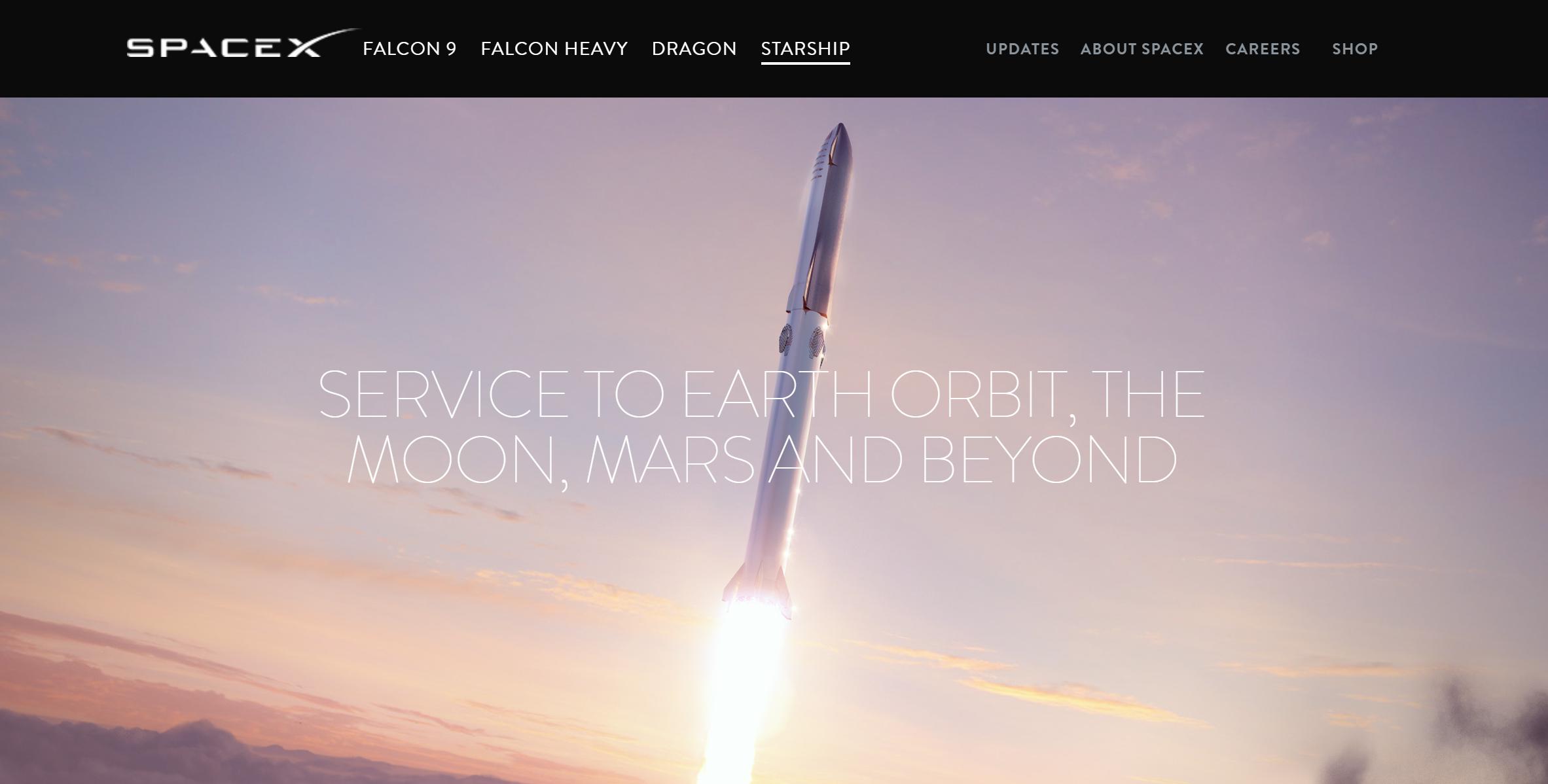
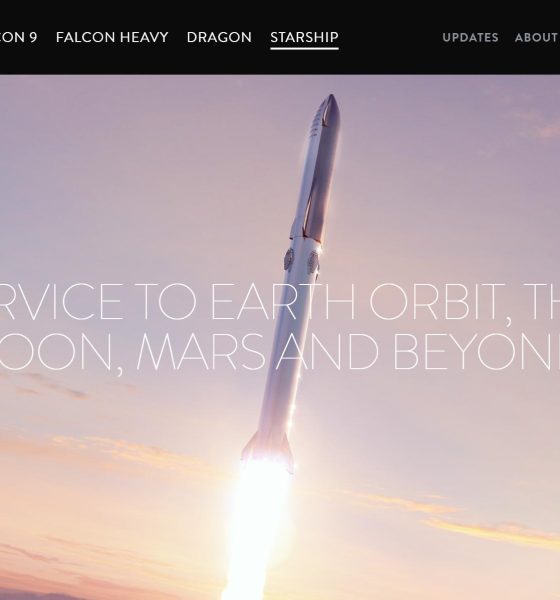
News
SpaceX publishes dedicated Starship webpage after Elon Musk’s presentation
Shortly after CEO Elon Musk’s 2019 presentation, SpaceX has published a new webpage dedicated to the next-generation Starship launch vehicle and its Super Heavy booster, detailing the rocket and providing some excellent new images and renders.
Beyond the images of Raptor and renders of Starship and Super Heavy, the webpage discusses several possible use-cases in Earth orbit and throughout the solar system, showing off the latest iteration of a cargo-focused Starship and teasing possible missions to the Space Station.
Known informally as “Chomper” in the spaceflight community, a cargo-optimized Starship would replace the pressurized crew section with a vast cargo bay and actuating door, the source of its nickname. Similar to but slightly simpler than the Space Shuttle’s famous clamshell doors, such a nose could be extremely useful. Although it could obviously be used to place massive payloads in orbit, a sealable cargo section could also be used to grab similarly large items on orbit and then either return them to Earth or service/repair them in situ.
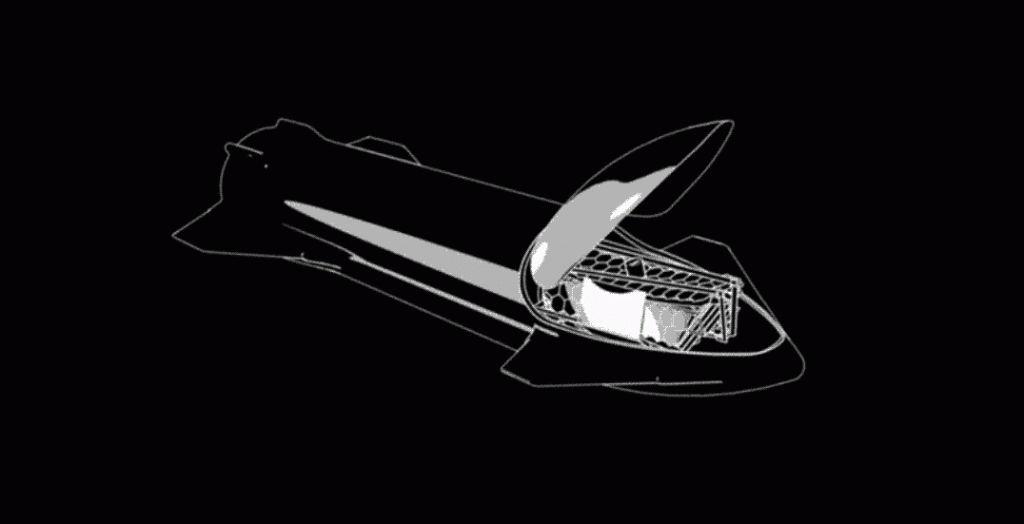
Of note, NASA’s Goddard Space Flight Center (GSFC) – responsible for the proposed LUVOIR super-telescope – has already seriously begun considering a cargo-optimized Starship as one of a handful of possible launch options. In the event that LUVOIR is chosen for development by NASA, the massive space telescope could be ready for launch sometime in the 2030s, at which point GSFC believes there will be only three plausible options – NASA’s SLS, Blue Origin’s New Glenn, or SpaceX’s Starship.
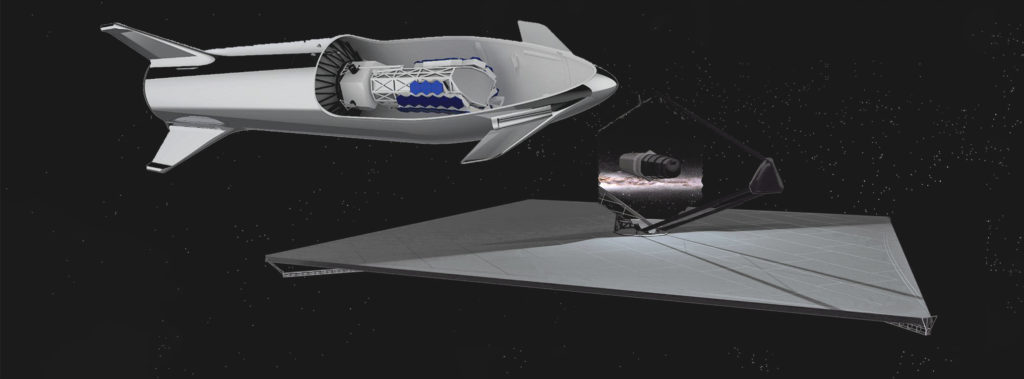
According to LUVOIR’s extensively detailed “Final Report”, published less than a month ago, GSFC worked fairly closely with SpaceX to determine where exactly Starship might fit into the picture. Intriguingly, an April 2019 tweet from the Center revealed that SpaceX had verified that Starship would be able to launch LUVOIR-B, a smaller and simpler version of the telescope. The August 2019 report, however, reveals that Starship could also launch LUVOIR-A – the full-sized telescope – with just a few slight modifications to Starship’s payload section.

SpaceX acknowledged Starship’s already well-known potential for transporting cargo and crew to the Moon and Mars, but also noted that the massive spacecraft could be used to deliver cargo and crew to the International Space Station (ISS) or elsewhere in Earth orbit. The ISS is undeniably large but Starship is (relatively) even bigger, nominally featuring enough pressurized volume (~1000m3 vs ~910m3) to more than double the habitable capacity of the ISS upon arrival. CEO Elon Musk noted this in an offhand remark on September 28th, cognizant of the fact that a Starship on its own is effectively a reusable ISS-class space station that can be placed in orbit with a single launch.
If a given Starship can support a crew of astronauts over a multi-month interplanetary cruise, the same Starship can also – and probably even more easily so – serve as an all-in-one space station with months of longevity. Add in Starship-enabled resupply and refueling runs and SpaceX could likely sustain a fleet of autonomous space stations in Earth orbit with relative ease. Assuming SpaceX is interested, Starship launch prices are low enough, and a large enough market exists, Starship could almost instantly and singlehandedly take orbital tourism from a distant fantasy for billionaires to a serious market potentially accessible to hundreds of thousands or even millions of people.
Musk has noted in previous SpaceX presentations that the goal is to make Starship so reusable that the price of per-person tickets to Mars becomes comparable to buying a house ($500k to $1m). Assuming SpaceX gets close to that price target, the cost of a 100-person mission low Earth orbit – likely requiring just one launch – could potentially be comparable to buying a car (~$50,000).
Check out Teslarati’s Marketplace! We offer Tesla accessories, including for the Tesla Cybertruck and Tesla Model 3.

Elon Musk
Tesla CEO Elon Musk confirms Robotaxi safety monitor removal in Austin: here’s when
Musk has made the claim about removing Safety Monitors from Tesla Robotaxi vehicles in Austin three times this year, once in September, once in October, and once in November.
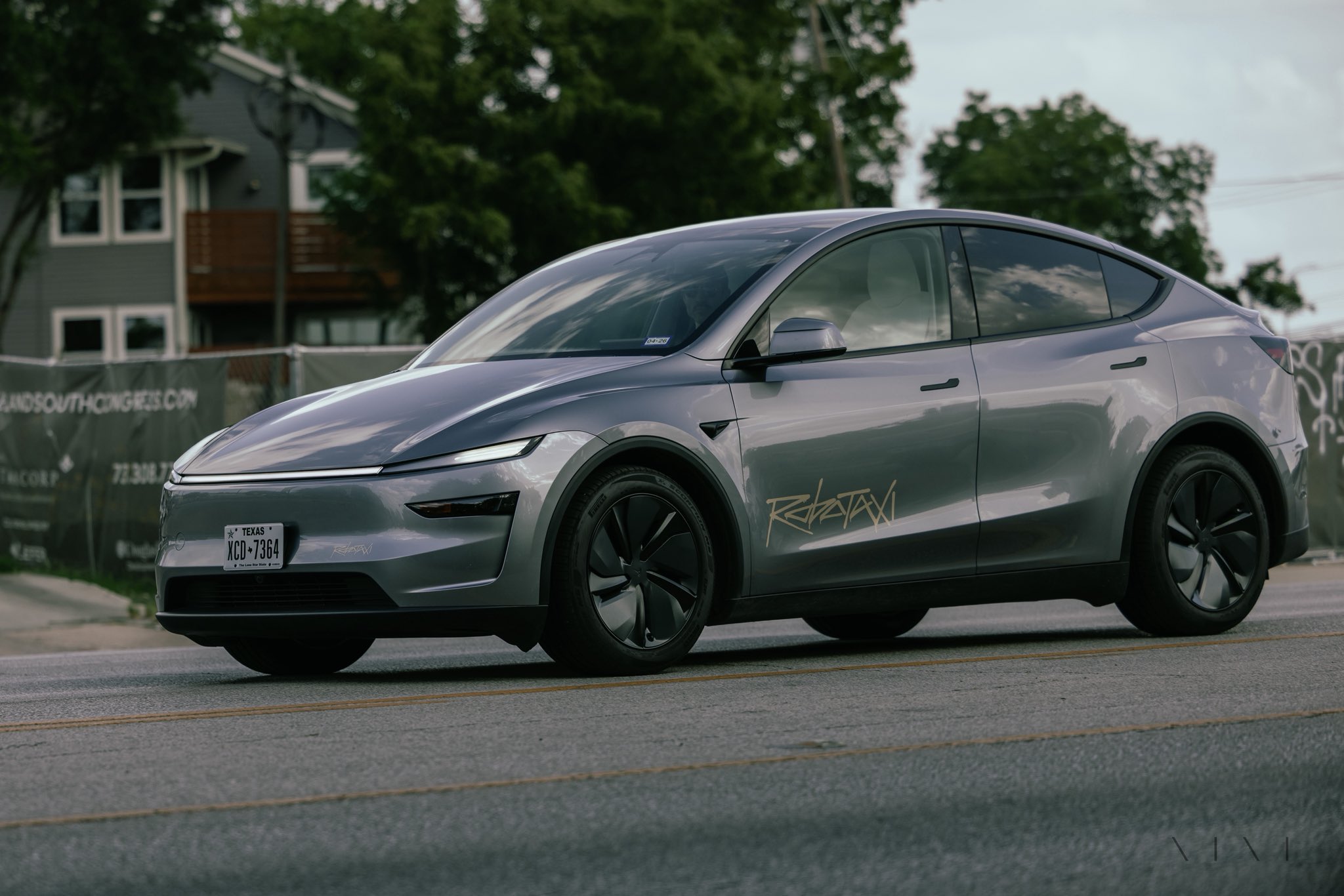
Tesla CEO Elon Musk confirmed on Tuesday at the xAI Hackathon that the company would be removing Safety Monitors from Robotaxis in Austin in just three weeks.
This would meet Musk’s timeline from earlier this year, as he has said on several occasions that Tesla Robotaxis would have no supervision in Austin by the end of 2025.
On Tuesday, Musk said:
“Unsupervised is pretty much solved at this point. So there will be Tesla Robotaxis operating in Austin with no one in them. Not even anyone in the passenger seat in about three weeks.”
Musk has made the claim about removing Safety Monitors from Tesla Robotaxi vehicles in Austin three times this year, once in September, once in October, and once in November.
In September, he said:
“Should be no safety driver by end of year.”
The safety driver is just there for the first few months to be extra safe.
Should be no safety driver by end of year.
— Elon Musk (@elonmusk) September 4, 2025
On the Q3 Earnings Call in October, he said:
“We are expecting ot have no safety drivers in at least large parts of Austin by the end of this year.”
Finally, in November, he reiterated the timeline in a public statement at the Shareholder Meeting:
“I expect Robotaxis to operate without safety drivers in large parts of Austin this year.”
Currently, Tesla uses Safety Monitors in Austin in the passenger’s seat on local roads. They will sit in the driver’s seat for highway routes. In the Bay Area ride-hailing operation, there is always a Safety Monitor in the driver’s seat.
Three weeks would deliver on the end-of-year promise, cutting it close, beating it by just two days. However, it would be a tremendous leap forward in the Robotaxi program, and would shut the mouths of many skeptics who state the current iteration is no different than having an Uber.
Tesla has also expanded its Robotaxi fleet this year, but the company has not given exact figures. Once it expands its fleet, even more progress will be made in Tesla’s self-driving efforts.
News
SpaceX reportedly mulling IPO, eyeing largest of all time: report
“I do want to try to figure out some way for Tesla shareholders to participate in SpaceX. I’ve been giving a lot of thought to how to give people access to SpaceX stock,” Musk said.

SpaceX is reportedly mulling an initial public offering, eyeing what would be the largest valuation at the time of availability of all time, a new report from Bloomberg said on Tuesday.
It is one of many reports involving one of Elon Musk’s companies and a massive market move, as this is not the first time we have seen reports of an IPO by SpaceX. Musk himself has also dispelled other reports in the past of a similar nature, including an xAI funding round.
SpaceX and Musk have yet to comment on the report. In the past, untrue reports were promptly replied to by the CEO; this has not yet gained any response, which is a good sign in terms of credibility.
However, he said just a few days ago that stories of this nature are inaccurate:
“There has been a lot of press claiming SpaceX is raising money at $800B, which is not accurate. SpaceX has been cash flow positive for many years and does periodic stock buybacks twice a year to provide liquidity for employees and investors. Valuation increments are a function of progress with Starship and Starlink and securing global direct-to-cell spectrum that greatly increases our addressable market. And one other thing that is arguably most significant by far.”
There has been a lot of press claiming @SpaceX is raising money at $800B, which is not accurate.
SpaceX has been cash flow positive for many years and does periodic stock buybacks twice a year to provide liquidity for employees and investors.
Valuation increments are a…
— Elon Musk (@elonmusk) December 6, 2025
Musk has discussed a potential IPO for SpaceX in recent months, as the November 6 shareholder meeting, as he commented on the “downsides” of having a public company, like litigation exposure, quarterly reporting pressures, and other inconveniences.
Nevertheless, Musk has also said he wants there to be a way for Tesla shareholders to get in on the action. At the meeting in early November, he said:
“I do want to try to figure out some way for Tesla shareholders to participate in SpaceX. I’ve been giving a lot of thought to how to give people access to SpaceX stock.”
Additionally, he added:
“Maybe at some point., SpaceX should become a public company despite all the downsides of being public.”
Musk has been historically reluctant to take SpaceX public, at times stating it could become a barrier to colonizing Mars. That does not mean it will not happen.
Bloomberg’s report cites multiple unidentified sources who are familiar with the matter. They indicate to the publication that SpaceX wants to go public in mid-to-late 2026, and it wants to raise $30 billion at a valuation of around $1.5 trillion.
This is not the first time SpaceX has discussed an IPO; we reported on it nine years ago. We hope it is true, as the community has spoken for a long time about having access to SpaceX stock. Legendary investor Ron Baron is one of the lucky few to be a SpaceX investor, and said it, along with Tesla, is a “lifetime investment.”
Tesla bull Ron Baron reveals $100M SpaceX investment, sees 3-5x return on TSLA
The primary driver of SpaceX’s value is Starlink, the company’s satellite internet service. Starlink contributes 60-70 percent of SpaceX’s revenue, meaning it is the primary value engine. Launch services, like Falcon 9 contracts, and the development of Starship, also play supporting roles.
News
SpaceX reaches incredible milestone with Starlink program
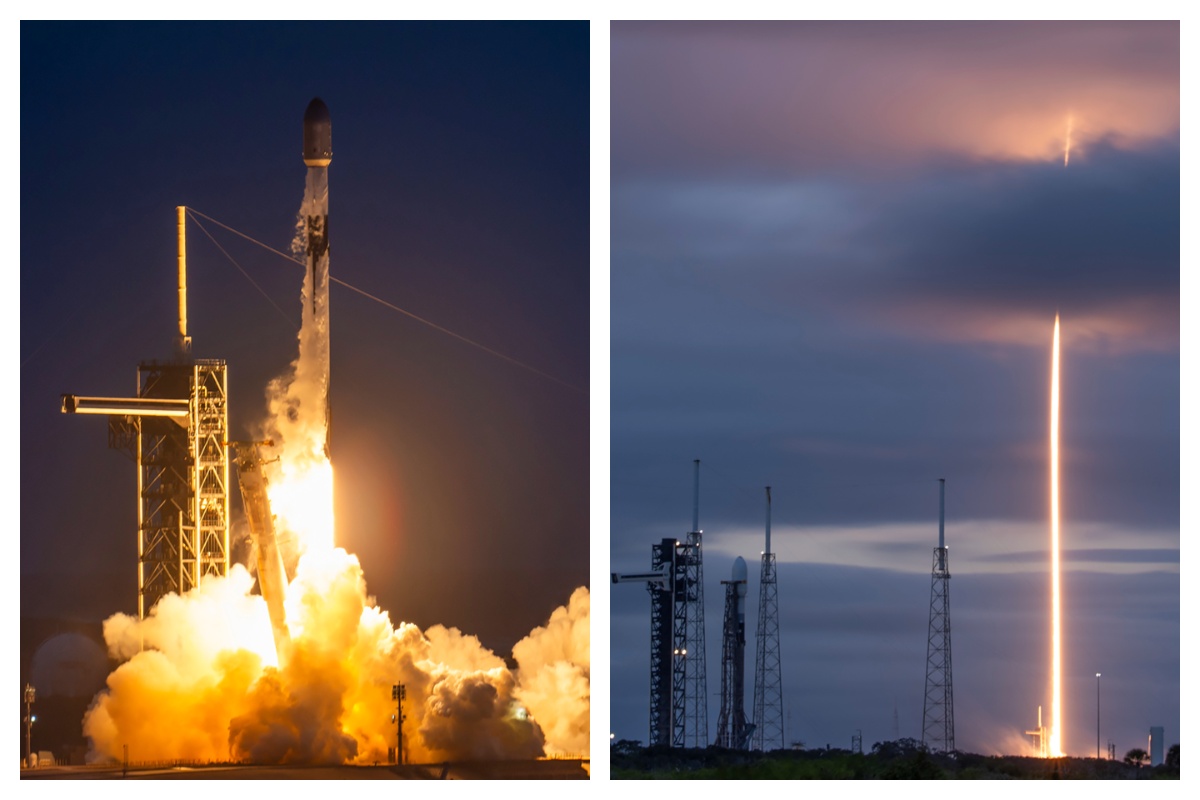
SpaceX reached an incredible milestone with its Starlink program with a launch last night, as the 3,000th satellite of the year was launched into low Earth orbit.
On Monday, SpaceX also achieved its 32nd flight with a single Falcon 9 rocket from NASA’s Kennedy Space Center.
The mission was Starlink 6-92, and it utilized the Falcon 9 B1067 for the 32nd time this year, the most-used Falcon booster. The flight delivered SpaceX’s 3000th Starlink satellite of the year, a massive achievement.
There were 29 Starlink satellites launched and deployed into LEO during this particular mission:
Falcon 9 launches 29 @Starlink satellites from Florida pic.twitter.com/utKrXjHzPN
— SpaceX (@SpaceX) December 9, 2025
SpaceX has a current goal of certifying its Falcon boosters for 40 missions apiece, according to Spaceflight Now.
The flight was the 350th orbital launch from the nearby SLC-40, and the 3,000 satellites that have been successfully launched this year continue to contribute to the company’s goal of having 12,000 satellites contributing to global internet coverage.
There are over five million users of Starlink, the latest data shows.
Following the launch and stage separation, the Falcon 9 booster completed its mission with a perfect landing on the ‘Just Read the Instructions’ droneship.
The mission was the 575th overall Falcon 9 launch, highlighting SpaceX’s operational tempo, which continues to be accelerated. The company averages two missions per week, and underscores CEO Elon Musk’s vision of a multi-planetary future, where reliable connectivity is crucial for remote work, education, and emergency response.
As Starlink expands and works toward that elusive and crucial 12,000 satellite goal, missions like 6-92 pave the way for innovations in telecommunications and enable more internet access to people across the globe.
With regulatory approvals in over 100 countries and millions of current subscribers, SpaceX continues to democratize space, proving that reusability is not just feasible, but it’s also revolutionary.








